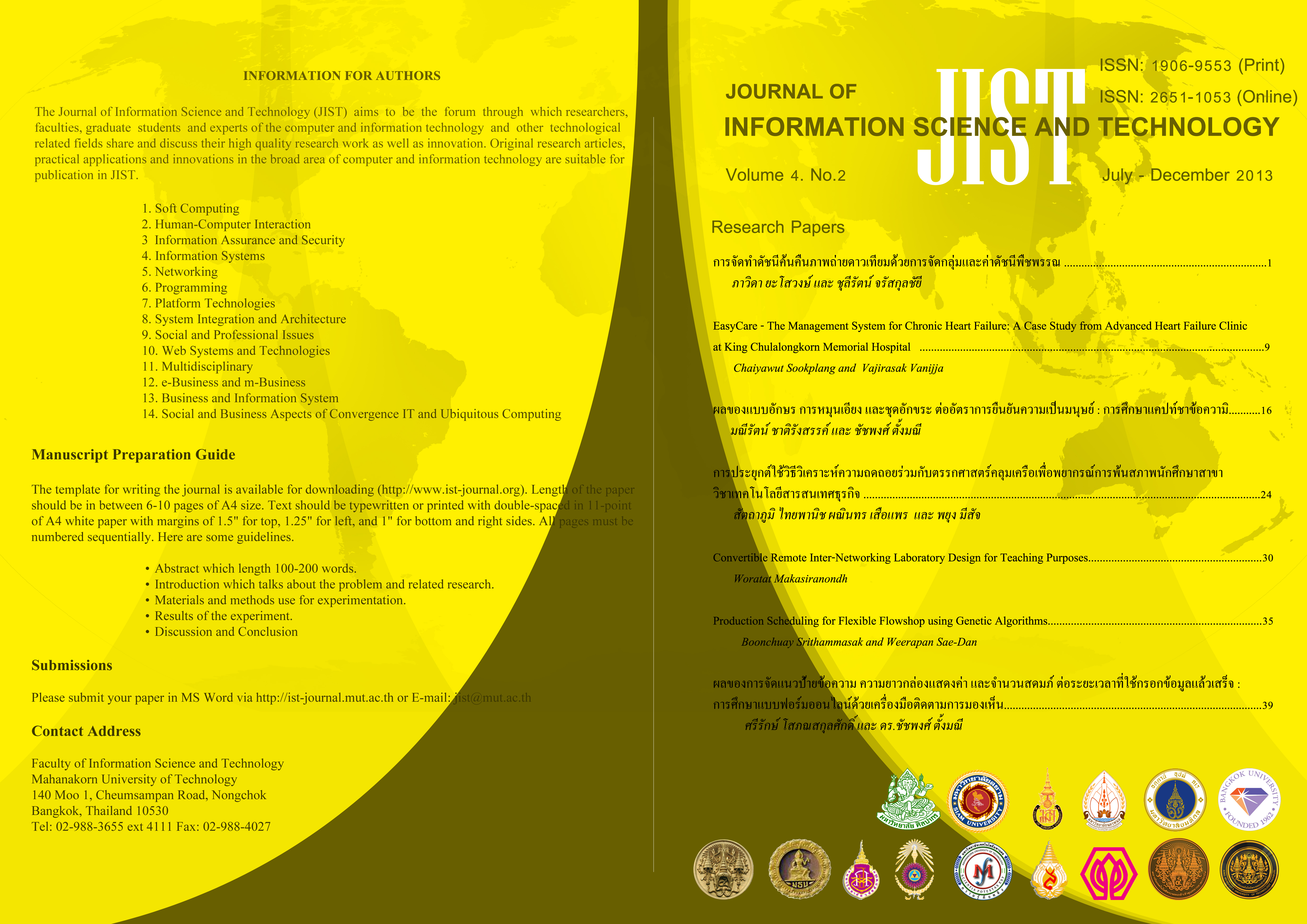Effects of Label Alignments, Field Lengths and Number of Columns on Completion Time: An Examination of Online Form Using an Eye-Tracking Device
Main Article Content
Abstract
- Online form is an important tool for data collection. Designed to be easy to use, the user could be happy to cooperate. One measurement of efficiency is completion time, By that definition is start a timer from user begin to enter the form until the transmission. The variables that may affect the design quality include (1) label alignments (2) field lengths and (3) number of columns. Therefore, this study examined the effects of (1) label alignments (2) field lengths and (3) number of columns on completion time with eye-tracking device. The analysis indicated that the effect of field lengths and number of columns are statistically significant on completion time at the 0.05 level, but the effects of label alignments was not significant. In addition to extending knowledge of online form’s design, researchers also may be used as the basis for the design of the form as well.
Article Details
This work is licensed under a Creative Commons Attribution-NonCommercial-NoDerivatives 4.0 International License.
I/we certify that I/we have participated sufficiently in the intellectual content, conception and design of this work or the analysis and interpretation of the data (when applicable), as well as the writing of the manuscript, to take public responsibility for it and have agreed to have my/our name listed as a contributor. I/we believe the manuscript represents valid work. Neither this manuscript nor one with substantially similar content under my/our authorship has been published or is being considered for publication elsewhere, except as described in the covering letter. I/we certify that all the data collected during the study is presented in this manuscript and no data from the study has been or will be published separately. I/we attest that, if requested by the editors, I/we will provide the data/information or will cooperate fully in obtaining and providing the data/information on which the manuscript is based, for examination by the editors or their assignees. Financial interests, direct or indirect, that exist or may be perceived to exist for individual contributors in connection with the content of this paper have been disclosed in the cover letter. Sources of outside support of the project are named in the cover letter.
I/We hereby transfer(s), assign(s), or otherwise convey(s) all copyright ownership, including any and all rights incidental thereto, exclusively to the Journal, in the event that such work is published by the Journal. The Journal shall own the work, including 1) copyright; 2) the right to grant permission to republish the article in whole or in part, with or without fee; 3) the right to produce preprints or reprints and translate into languages other than English for sale or free distribution; and 4) the right to republish the work in a collection of articles in any other mechanical or electronic format.
We give the rights to the corresponding author to make necessary changes as per the request of the journal, do the rest of the correspondence on our behalf and he/she will act as the guarantor for the manuscript on our behalf.
All persons who have made substantial contributions to the work reported in the manuscript, but who are not contributors, are named in the Acknowledgment and have given me/us their written permission to be named. If I/we do not include an Acknowledgment that means I/we have not received substantial contributions from non-contributors and no contributor has been omitted.
References
2. Bojko, A., and Schumacher, R.M. Eye Tracking and Usability Testing in Form Layout Evaluation. Las Vegas, NV. Online]. 2008. Available from: http://www.bfma.org 2011, December 25]
3. Duchowski, A.T. Eye Tracking Methodology: Theory and Practice. Springer, London, UK, 2002.
4. Hartley, J., Burnhill, P., and Fraser, P. Typographical Problems of Journal Design. Applied Ergonomics, Vol.5, pp.15-20, 1974.
5. Jarrett, C. Caroline’s Corner: Two-Column Forms are best Avoided.Usability News, BCS, UK. Online]. 2006. Available from: http://usabilitynews.bcs.org 2012, February 8]
6. Jarrett, C. and Gaffney, G. Forms that Work Designing Web Forms for Usability. Chapter. 7, pp.121-140, 2009.
7. Manfreda, K.L., Batagelj, Z., and Vehovar, V. Design of Web Survey Questionnaires: Three Basic Experiments.Journal of Computer Mediated Communication 7, 2002.
8. McEwan, T., Das, S., and Douglas, D. Using Eye-Tracking to Evaluate Label Alignment in Online. ACM, Edinburgh, U.K., 2008.
9. Norman, K. L., Friedman, Z., Norman, K., and Stevenson, R. Navigational Issues in the Design of Online Self-Administered Questionnaires. Behavior and Information Technology, Vol.20 (1), pp.37-45, 2001.
10. Nielsen, J. F-Shaped Pattern for Reading Web Content. Online]. 2006. Available from: http://www.useit.com 2012, January 12]
11. Penzo, M. Label Placement in Forms. Online]. 2006. Available from: http://www.uxmatters.com 2012, February 8]
12. Penzo, M. Evaluating the Usability of Search Forms Using Eye-Tracking: A Practical Approach. Online]. 2006. Available from: http://www.uxmatters.com 2012, February 8]
13. Slota, J. What’s The Average Length of an Email Address? Online]. 2009. Available from: http://janusz.slota.name 2012, January 8]
14. Wroblewski, L. Web Form Design - Filling in the Blanks.Chapter.4, pp.87-105. Online]. 2008. Available from: http://www.4shared.com 2011, December 21]
15. Zukerberg, A., Nichols, E., and Tedesco, H. Designing Surveys for the Next Millennium: Internet Questionnaire Design Issues. The 54th Annual Conference of the American Association for Public Opinion Research, St. Petersburg, Florida, 1999.
16. กัลยา วานิชย์บัญชา. การวิเคราะห์สถิติ: สถิติสาหรับการบริหารและวิจัย. พิมพ์ครั้งที่ 6. กรุงเทพฯ: โรงพิมพ์แห่งจุฬาลงกรณ์มหาวิทยาลัย, 2545.
17. กัลยา วานิชย์บัญชา. สถิติสาหรับงานวิจัย. พิมพ์ครั้งที่ 2. กรุงเทพฯ: โรงพิมพ์แห่งจุฬาลงกรณ์มหาวิทยาลัย, 2549.
18. กัลยา วาณิชย์บัญชา. สถิติสาหรับงานวิจัย. พิมพ์ครั้งที่ 5. กรุงเทพฯ: สานักพิมพ์แห่งจุฬาลงกรณ์มหาวิทยาลัย, 2553.
19. กัลยา วานิชย์บัญชา. การใช้ SPSS for Windows ในการวิเคราะห์ข้อมูล. กรุงเทพฯ : โรงพิมพ์จุฬาลงกรณ์มหาวิทยาลัย, 2554.
20. กัลยา วานิชย์บัญชา. หลักสถิติ. พิมพ์ครั้งที่ 8. กรุงเทพฯ: โรงพิมพ์แห่งจุฬาลงกรณ์มหาวิทยาลัย, 2551.
21. ทิพย์สุดา จันทร์แจ่มหล้า. การวิเคราะห์ข้อมูลด้วยโปรแกรม SPSS. ออนไลน์]. 2551.แหล่งที่มา: http://suanpalm3.kmutnb.ac.th 2555, เมษายน 1]
22. ธนพล ฉันจรัสวิชัย. สร้างเว็บเพ็จง่ายๆ ด้วย Microsoft FrontPage 2000. กรุงเทพฯ: บริษัท เอช.เอ็น. กรุ๊ป จากัด, 2543.
23. ธนัท สมานกูลทอง."การเปรียบเทียบระยะเวลาที่ใช้ตอบแบบสอบถามออนไลน์และทัศนคติต่อแบบสอบถาม เมื่อใช้รูปแบบมาตรการประเมิน สัญลักษณ์ค่าประเมินและรูปแบบกล่องแสดงค่าที่แตกต่างกัน". วิทยานิพนธ์ปริญญามหาบัณฑิต, สาขาวิชาการพัฒนาซอฟต์แวร์เพื่อธุรกิจ, ภาควิชาสถิติ, คณะพาณิชยศาสตร์และการบัญชี, จุฬาลงกรณ์มหาวิทยาลัย, 2552.
24. พนิดา พานิชกุล. เทคโนโลยีสารสนเทศ (Information Technology). พิมพ์ครั้งที่3. กรุงเทพฯ : เคทีพี คอมพ์แอนด์คอนซัลท์, 2553.
25. เหมือนมาส พุ่มลาเจียก. "ระยะเวลาที่ใช้ตอบและการแจกแจงของคาตอบจากแบบสอบถามออนไลน์ทางธุรกิจเมื่อรูปแบบมาตรประมาณค่าและลักษณะการจัดหน้าแตกต่างกัน". วิทยานิพนธ์ปริญญามหาบัณฑิต, สาขาวิชาการพัฒนาซอฟต์แวร์เพื่อธุรกิจ, ภาควิชาสถิติ, คณะพาณิชยศาสตร์และการบัญชี, จุฬาลงกรณ์มหาวิทยาลัย, 2550.
26. สานักงานเลขานุการคณะกรรมการเทคโนโลยีสารสนเทศแห่งชาติ, ศูนย์เทคโนโลยีอิเล็กทรอนิกส์และคอมพิวเตอร์. รายงานผลการสารวจกลุ่มผู้ใช้อินเทอร์เน็ตในประเทศไทย. 2542-2552.
27. สานักงานเลขานุการคณะกรรมการเทคโนโลยีสารสนเทศแห่งชาติ, ศูนย์เทคโนโลยีอิเล็กทรอนิกส์และคอมพิวเตอร์. รายงานผลการสารวจกลุ่มผู้ใช้อินเทอร์เน็ตในประเทศไทย. 2553.



